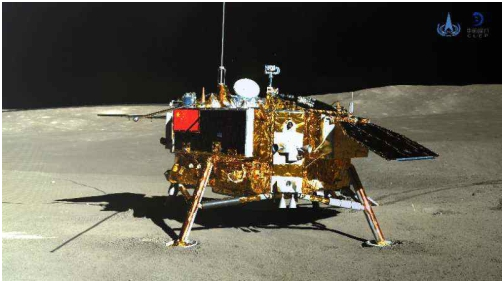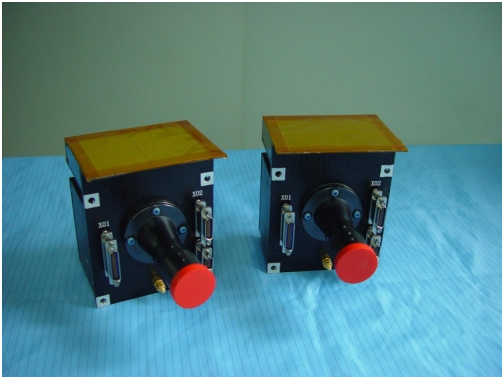At 2:23, Dec. 8, 2018, Chang’e-4 Probe was successfully launched from the Xichang Satellite Launch Center, starting its new journey of lunar exploration. The launch is an important link (as “Falling”) in the “Circling, Falling and Returning” trilogy of China’s Lunar Exploration Program.
By far, Chang’e-1 Satellite has successfully completed the mission of circling the moon. The Phase II works consist of the tasks by Chang’e-2, Chang’e-3 and Chang’e-4. Chang’e-2, as the first satellite in the phase, has satisfactorily proven some key technologies for Chang’e-3 and carried out critical detection of the preselected landing area. In 2013, Chang’e-3 successfully fell on the moon and conducted inspection and prospecting of lunar surface. Chang’e-3 Lander has become the man-made spacecraft working for the longest time on the moon’s surface.
In 2014, after Chang’e-3 completed the tasks successfully, the State Administration of Science, Technology and Industry for National Defence took the lead to organize the demonstration for adjusting the task implementation scheme of Chang’e-4. On the basis of comprehensive consideration of international cutting-edge factors, scientific value and economic and technological feasibility as well as other factors, the Administration finally determined the overall scheme for soft landing on and inspection and prospecting of the far side of the moon. The far side, with unique electromagnetic field environment and geologic characteristics, is particularly suitable for space-astronomy studies like low-frequency radio detection and other scientific researches such as detection of components in the substance on the moon. Meanwhile, landing on and detection of the far side of the moon is a blank in the world, and will help enhance human’s cognition of any unknown mysteries in the universe.
The work of Chang’e-4 was launched officially in Jan. 2016, consisting of two tasks of relay satellite and probe. “Queqiao (Magpie Bridge)” Relay Satellite was successfully launched by CZ-4CY27 carrier rocket from the Xichang Satellite Launch Center on May 21, 2018, and entered the mission orbit at the circumearth /lunar Lagrangian Point L2.
At 10:26, Jan. 3, 2019, Chang’e-4 Probe, after earth-moon transfer, braking at perilune and circumlunar flight, realized human’s first soft landing on the far side of the moon, carried out the detection for parking in place and inspection on the far side, and realized the relay communication between the far side and the earth through the “Queqiao (Magpie Bridge)” Relay Satellite running on the mission orbit.
On the afternoon of Jan. 11, 2019, Chang’e-4 Lander and Yutu II Lunar Rover worked normally, and completed the mutual shooting smoothly under supports of the “Queqiao (Magpie Bridge)”Relay Satellite. Meanwhile, the ground-received images were clear and sound, the Chinese and foreign scientific loads worked normally, the prospecting data were transmitted to the ground effectively, and the carried scientific experiment projects were conducted smoothly and reached the set objectives, marking a great success of Chang’e-4. Through ground data receiving and processing, at 16:47, the big screen in the Beijing Aerospace Control Center presented images of mutual shooting between the Lander and the Lunar Rover. The images clearly showed the topography and relief of the far side around the Lander and Lunar Rover, with the Five-Starred Red Flag on them striking particularly. The panoramic camera by Xi’an Institute of Optics and Precision Mechanics, Chinese Academy of Sciences (XIOPM, CAS below) helped all people in the world see the bright Five-Starred Red Flag shining on the far side of the moon on the China-made probes.
As the “Sister Satellite” of Chang’e-3, Chang’e-4 has the panoramic camera for taking color pictures of the Lander. Two such cameras were mounted to the mast of the Lunar Rover, just like people’s eyes, to realize stereo imaging of the lunar surface on the inspection area in accordance with the principle of “binocular stereo vision” similar to human eyes. With the mast’s horizontal rotation and up-down pitching, they realized large-view-field and up-down large-range panoramic imaging, and then got panoramic 3D stereo images of the inspection area through image stitching and stereo inversion, so as to reach the scientific goals of 3D optical imaging of the lunar surface on the inspection area, relevant topography and relief studies, lunar craters survey and research, analysis of the geologic structure of the moon and comprehensive researches.
The panoramic cameras in Chang’e-4 have two imaging modes, namely black-and-white imaging and color imaging, and can realize infinite-distance clear imaging from the foot of the Lunar Rover to the margin of the moon, and millimeter-magnitude space resolution when in short-distance observation. Images by the panoramic cameras will also play some roles in prospecting by other loads in the Lunar Rover.
XIOPM, in accordance with the national scientific layout of the Lunar Exploration Program and relevant deep-space exploration, and on the basis of its backbone having participated in the Lunar Exploration Program for a long time, established the research office for lunar and deep-space exploration technologies. Since Phase I of the Lunar Exploration Program, the team has undertaken research and development of the CCD 3D camera and interference imaging spectrograph for Chang’e-1, the CCD 3D camera for Chang’e-2, the panoramic camera and moon-based optical telescope for Chang’e-3, and the panoramic camera for Chang’e-4 as well as other effective loads, and successfully completed all engineering tasks and scientific goals.
Chang’e-1’s CCD 3D camera obtained China’s first full-moon stereo photo with the ground resolution of 120m, clear image and rich levels, and as the most complete full-lunar-surface image in the world at that time; Chang’e-1’s interference imaging spectrograph got clear multispectral image of 84% of the lunar surface area, from which the original data helped relevant scientists give inversion of the distribution of main minerals on the lunar surface and contents of elements such as aluminum, magnesium and titanium. Chang’e-2’s CCD 3D camera got China’s first full-moon image with the resolution better than 7m and images of the Sinus Iridum area on the lunar surface with the resolution of 1.3m, detecting the “footing” for Chang’e-3’s landing on the moon; the Chang’e-3’s panoramic camera carried by “Yutu” Lunar Rover realized China’s first high-resolution field stereo imaging of the lunar surface, and acquired massive scientific data for studying the topography and relief on the lunar surface, and clear and bright color pictures of the Lander, providing the guarantee for mutual shooting between the Lunar Rover and the Lander marking the great success of Chang’e-3; the moon-based optical telescope realized human’s first moon-based astronomical observation, and has been working normally since it landed on the lunar surface, and sent back tens thousands of star charts gained from the lunar surface, making it the load acquiring the most effective data in Chang’e-3. Meanwhile, it is also the only load still working in Chang’e-3.
![]() XIOPM, a main force with rich experiences and exquisite technologies in China’s deep-space exploration field, currently undertakes follow-up tasks of the Lunar Exploration Program and the first Mars exploration task. It will closely center on national demands in space science engineering to actively participate in the later stage of the Lunar Exploration Program, small planets exploration, Jupiter exploration and other deep-space exploration task planning, and boost continuous progress of China in the deep-space exploration field. (By the Research Office for Lunar and Deep-space Exploration Technologies, the Quality and Planning Office and the Comprehensive Office)
XIOPM, a main force with rich experiences and exquisite technologies in China’s deep-space exploration field, currently undertakes follow-up tasks of the Lunar Exploration Program and the first Mars exploration task. It will closely center on national demands in space science engineering to actively participate in the later stage of the Lunar Exploration Program, small planets exploration, Jupiter exploration and other deep-space exploration task planning, and boost continuous progress of China in the deep-space exploration field. (By the Research Office for Lunar and Deep-space Exploration Technologies, the Quality and Planning Office and the Comprehensive Office)

Clear panoramic photo that the Lander carries a Five-Starred Red Flag by the Lunar Rover

Sample Products of Chang’e-4’s Panoramic Camera
Download: